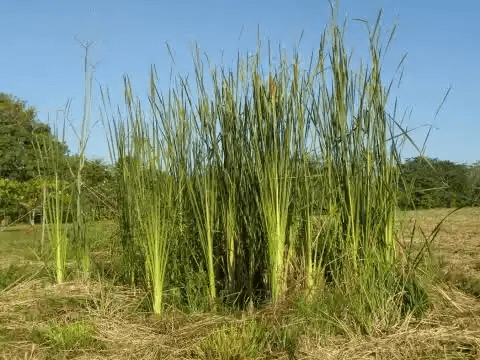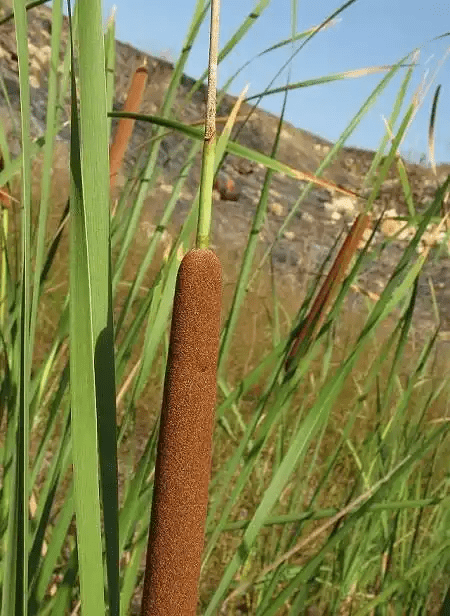Typha domingensis, commonly known as Southern Cattail, is a robust and versatile aquatic plant that belongs to the Typhaceae family. This perennial herbaceous plant is native to the Americas, where it thrives in various wetland habitats, making it a notable and ecologically significant species.
Southern Cattail typically boasts a tall and erect stem that can reach heights of up to 10 feet (3 meters). The stem is cylindrical, unbranched, and characterized by a smooth texture.
The plant’s distinctive linear leaves emerge from the base, providing an elegant and lush appearance. These leaves are flat, elongated, and often display a vibrant green coloration.
One of the most recognizable features of Typha domingensis is its inflorescence – the flower spike. The compact, cylindrical flower head, known as a spike, forms at the top of the stem.
This structure is composed of numerous small, densely packed flowers. The male and female flowers are spatially separated on the spike, a common trait in the Typha genus.
As the plant matures, the female flowers develop a unique structure resembling a cigar, which is a defining characteristic of Southern Cattail.
This cylindrical structure consists of densely packed seeds attached to a central stalk. The male flowers, on the other hand, produce a fluffy, pollen-laden mass that facilitates wind dispersal.
Southern Cattail is highly adaptive and can thrive in a variety of wetland habitats, including freshwater marshes, pond edges, and the margins of slow-moving streams.
It exhibits a remarkable tolerance to fluctuating water levels and is often found in both permanent and seasonal water bodies.
This species is widely distributed across the Americas, ranging from the southeastern United States to South America. Its ability to colonize diverse wetland environments has contributed to its success as a widespread and ecologically significant plant.
Typha domingensis plays a crucial role in wetland ecosystems. Its dense stands provide habitat and nesting sites for various aquatic and bird species.
The plant’s rhizomatous growth pattern stabilizes soil, preventing erosion and contributing to the overall health of wetland ecosystems. Additionally, Southern Cattail helps improve water quality by absorbing excess nutrients and filtering sediment from the water.
The Botanical Description of Typha domingensis
1. Life: Typha domingensis, commonly known as Southern Cattail, belongs to the Typhaceae family. It features tall, slender stems crowned with cylindrical flower spikes, resembling hotdogs on sticks.
2. Leaves: The plant’s long, narrow, blade-like leaves contribute to its aesthetic appeal, showcasing a vibrant green hue.
3. Reproduction: Typha domingensis is dioecious, meaning individual specimens are either male or female, ensuring genetic diversity.
4. Habitat: Thriving in freshwater environments, this plant is commonly found in wetlands, marshes, and along the edges of ponds and lakes.
5. Growth Form: Typha domingensis exhibits a rhizomatous growth form, spreading through underground rhizomes, forming dense colonies in aquatic ecosystems.
The Geographic Distribution of Typha domingensis
1. Native Regions: Typha domingensis is native to the Americas, extending from the southern United States through Central and South America.
2. Global Spread: Due to adaptability, it has spread globally, establishing in Europe, Asia, Africa, and Australia in various aquatic habitats.
3. Preferred Habitats: Thriving in areas with abundant sunlight and nutrient-rich soils, it commonly inhabits wetlands, marshes, and freshwater ecosystems.
4. Ecological Impact: While providing habitat and food for wildlife, its aggressive growth can displace native vegetation, impacting ecosystems.
The Chemical Composition of Typha domingensis
1. Phytochemicals: Typha domingensis contains flavonoids, tannins, and alkaloids, contributing to its medicinal and ecological significance.
2. Nutritional Value: Rich in carbohydrates and proteins, it has been traditionally used for dietary purposes by indigenous communities.
3. Medicinal Uses: Extracts show antimicrobial and anti-inflammatory properties, suggesting potential in natural medicine.
4. Environmental Remediation: Recognized for absorbing pollutants from water, Typha domingensis plays a crucial role in environmental remediation.
In conclusion, Typha domingensis, with its botanical allure, global presence, and chemical prowess, stands as a remarkable player in nature’s symphony, showcasing versatility in its contributions to ecosystems, human nutrition, and potential medicinal applications.
Read Also: How to Farm and Care for European Anchovy Fish (Engraulis encrasicolus)
The Medicinal Health Benefits Of Typha domingensis (Southern Cattail)

1. Immune System Support: Typha domingensis has been linked to immune system enhancement, thanks to its rich phytochemical content, including flavonoids. These compounds contribute to the plant’s immune-boosting properties.
2. Anti-Inflammatory Properties: The plant’s extracts showcase anti-inflammatory effects, making Typha domingensis a potential natural remedy for various inflammatory conditions. This includes ailments such as arthritis and other inflammatory disorders.
3. Antimicrobial Action: Studies suggest that Typha domingensis exhibits antimicrobial properties, making it a candidate for addressing bacterial and fungal infections. The plant’s compounds may help inhibit the growth of harmful microorganisms.
4. Digestive Health: Typha domingensis has traditionally been used to promote digestive health. Its consumption is believed to aid in digestion, alleviate gastrointestinal discomfort, and support overall digestive well-being.
5. Antioxidant Power: The presence of antioxidants in Typha domingensis contributes to its ability to combat oxidative stress in the body. These antioxidants may help neutralize free radicals, potentially reducing the risk of chronic diseases.
The Methods of Usage to Achieve the Provided Health Benefits Of Typha domingensis (Southern Cattail)
1. Herbal Infusions: One common method of utilizing Typha domingensis for its health benefits is through herbal infusions. Boiling the leaves or roots and consuming the resulting tea is believed to deliver the plant’s medicinal properties.
2. Poultices and Topical Applications: For addressing skin conditions or localized inflammation, creating poultices from Typha domingensis and applying them topically is a traditional method. This allows the skin to absorb the beneficial compounds.
3. Dietary Incorporation: Including Typha domingensis in the diet, either by consuming young shoots or incorporating the plant into various culinary preparations, is a practical approach to harness its nutritional and medicinal benefits.
4. Tinctures and Extracts: Extracting the active compounds from Typha domingensis to create tinctures or liquid extracts provides a concentrated form of the plant’s medicinal properties. These can be added to beverages or taken directly.
5. Capsule Supplements: In modern herbal medicine, Typha domingensis extracts are sometimes encapsulated for convenient consumption. This method ensures standardized dosages and easy integration into daily health routines.
The Side Effects Of Using Typha domingensis Medicinal Plant
1. Allergic Reactions: Some individuals may experience allergic reactions to Typha domingensis. It’s essential to monitor for signs of allergies, such as skin rashes, itching, or respiratory issues, when using the plant for medicinal purposes.
2. Gastrointestinal Discomfort: In some cases, excessive consumption of Typha domingensis may lead to gastrointestinal discomfort. This includes symptoms like nausea, vomiting, or diarrhea. Moderation is key to avoiding such side effects.
3. Interactions with Medications: Individuals taking medications should exercise caution when using Typha domingensis medicinally, as interactions with certain drugs may occur. Consultation with a healthcare professional is advisable.
4. Not Recommended for Pregnant Individuals: Pregnant individuals should avoid using Typha domingensis medicinally, as its effects during pregnancy are not well-documented. Safety considerations are paramount for maternal and fetal well-being.
Typha domingensis, with its medicinal prowess, offers a natural avenue for immune support, anti-inflammatory relief, and more. Understanding its benefits and methods of usage, coupled with awareness of potential side effects, empowers individuals seeking to integrate this botanical marvel into their health and wellness practices.
Read Also: Gray Leaf Spot (Stemphylium spp) – Symptoms and Damage Control
The Scientific Research and Studies of Typha domingensis (Southern Cattail)

1. Antioxidant Properties: Scientific research has delved into Typha domingensis’s antioxidant potential. Studies suggest that the plant’s extracts exhibit robust antioxidant properties, contributing to its ability to combat oxidative stress.
2. Anti-Inflammatory Effects: Researchers have explored the anti-inflammatory effects of Typha domingensis. The plant’s compounds show promise in mitigating inflammation, making it a subject of interest in the development of anti-inflammatory agents.
3. Antimicrobial Activity: Scientific studies have investigated Typha domingensis for its antimicrobial properties. Preliminary findings indicate that the plant may have inhibitory effects against certain bacteria and fungi, showcasing its potential in combating infections.
4. Gastrointestinal Benefits: Research has explored the traditional use of Typha domingensis for digestive health. Investigations suggest that the plant may have positive effects on the gastrointestinal system, promoting digestive well-being.
5. Wound Healing Properties: Some studies have focused on Typha domingensis’s potential in wound healing. The plant’s extracts demonstrate properties that may accelerate the healing process and reduce inflammation in topical applications.
The Safety Precautions and Recommendations In Using Typha domingensis (Southern Cattail) Medicinal Plant
1. Allergies: Exercise caution if you have allergies, as individuals may experience allergic reactions to Typha domingensis. Monitor for signs such as skin rashes, itching, or respiratory issues.
2. Dosage Moderation: To avoid gastrointestinal discomfort, it’s crucial to moderate the dosage of Typha domingensis. Excessive consumption may lead to symptoms like nausea, vomiting, or diarrhea.
3. Medication Interactions: Individuals taking medications should consult healthcare professionals before using Typha domingensis, as interactions with certain drugs may occur.
4. Pregnancy Considerations: Pregnant individuals should refrain from using Typha domingensis medicinally, as its effects during pregnancy are not well-documented. Prioritize safety for maternal and fetal well-being.
FAQs About Typha domingensis (Southern Cattail) Medicinal Plant
1. Can Typha domingensis be consumed daily?
While Typha domingensis is generally safe, moderation is key. Excessive consumption may lead to gastrointestinal discomfort. It’s advisable to consult with a healthcare professional for personalized recommendations.
2. Is Typha domingensis safe for pregnant individuals?
No, Typha domingensis is not recommended for pregnant individuals due to limited data on its effects during pregnancy. Safety precautions are paramount, and alternatives should be explored.
3. Are there any known drug interactions with Typha domingensis?
Yes, Typha domingensis may interact with certain medications. It is crucial to inform healthcare providers of any medicinal plant usage to prevent potential interactions.
4. Can Typha domingensis be applied topically for skin conditions?
Yes, Typha domingensis poultices have been traditionally used for skin conditions. However, it’s essential to perform a patch test and discontinue use if any adverse reactions occur.
Scientific research sheds light on Typha domingensis’s potential health benefits, while safety precautions and FAQs provide valuable insights for individuals considering its medicinal use.
Always prioritize informed decisions and consult with healthcare professionals when incorporating botanical remedies into your wellness routine.
Read Also: The Role of Livestock Farming in a Sustainable Food System

